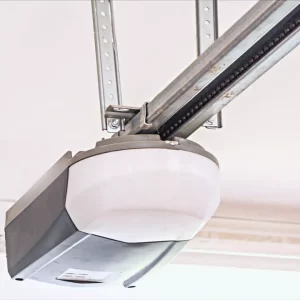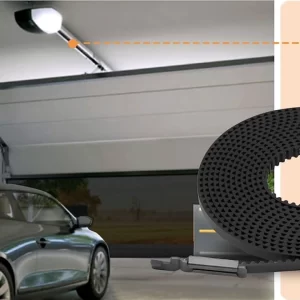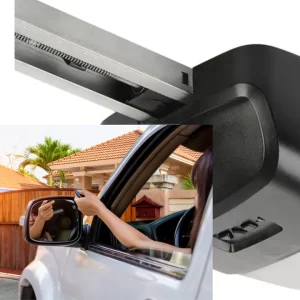Opening Doors to a Smarter Home: A Helpful Guide to Garage Door Openers
Why a Garage Door Opener?
Garage door openers enhances convenience, enabling door operation at the touch of a button. It enhances home security with changing codes and lock modes, and ensures safety with auto-reverse features and sensors. Additional benefits include built-in lighting for improved visibility, energy efficiency, and the ability to integrate with smart home systems for remote control and monitoring.
Brief History of Garage Door Openers
The first electric garage door opener was invented in 1926 by C.G. Johnson, founder of The Overhead Door Corporation. It’s interesting to note that 4 years earlier, he had invented the segmented overhead garage door.
In 1931 two separate teams, working independently, constructed the first remote-controlled electric garage door openers. Then in 1954, Alliance Manufacturing Co., now recognized as Genie Co., proudly asserts that they introduced the first mass-produced radio-controlled garage door opener.
Notably, Genie Co. was acquired by the Overhead Door Corp., in 1994.
Initially, these early models were expensive and considered a luxury item reserved for only the wealthiest homeowners. As time went on, however, garage door openers became more affordable and accessible to the average person.
Today there are many different types of garage door openers available on the market that cater to a wide range of budgets and preferences. Understanding the different types available on today’s market is handy for finding one that suits your needs best.
Types of Garage Door Openers
Garage door openers are classified into five main categories: Chain-drive, belt-drive, screw-drive, direct-drive and jackshaft openers. Each type has its unique benefits and drawbacks that homeowners should consider when choosing the right garage door opener for their home.
Chain-Drive Garage Door Openers

Chain-drive garage door openers have been in use for decades and remain a popular option for homeowners. They are affordable and reliable, making them a good choice for those on a budget.
A chain connects the trolley to the motor to raise and lower the door. One downside of chain-drive openers is that they can be quite noisy when in operation.
This is because the chains tend to rattle as they move along the metal rail. Additionally, these types of openers require regular maintenance, including lubrication of moving parts and tightening of loose nuts and bolts.
Belt-Drive Garage Door Openers

Belt-drive garage door openers use a rubber belt instead of a chain to lift and lower the door quietly. They are more expensive than chain-driven models but offer quieter operation with less maintenance required.
Belt drives are stronger than traditional chains, making them able to lift heavier doors with ease. They also tend to last longer than other types because they don’t experience wear and tear like chains do over time.
Screw-Drive Garage Door Openers

Screw-drive garage door openers operate by using a threaded steel rod rather than a chain or belt. The motor moves up and down along the rod, which rotates as it moves within its housing unit.
Screw drive openers are known for their reliability; however, they can be quite loud during operation. Additionally, these models require regular lubrication so that the moving parts function smoothly over time.
Direct-Drive Garage Door Openers

Direct-drive garage door openers are the quietest option on the market. They operate by using a stationary motor that moves along a chain attached to the garage door. This design eliminates the need for belts or screws, which reduces noise and maintenance requirements.
While they require minimal maintenance, direct-drive openers tend to be more expensive than other types. However, their reliability and quiet operation make them a popular option for homeowners who value peace of mind.
Jackshaft Garage Door Openers

Jackshaft garage door openers are installed on the wall beside the garage door, using a powerful motor to turn the torsion bar and raise or lower the door. They free up ceiling space and are ideal for garages with high or angled ceilings. Despite their higher cost, they provide quiet, smooth operation with reduced vibration. Jackshaft systems are designed to handle heavier, wider doors, and offer increased durability with minimal wear over time. Additionally, they can integrate seamlessly with home automation systems for enhanced convenience
Pros and Cons
| Type | Pros | Cons |
| Chain Drive | Affordable, strong, less likely to slip, widely available | Noisy operation, more maintenance required, may wear faster |
| Belt Drive | Quiet operation, less maintenance required, can lift heavy doors, long-lasting | More expensive than chain-drive models |
| Screw Drive | Requires less maintenance, robust, efficient | Noisier than belt and direct-drive models, sensitivity to temperature may affect performance |
| Direct Drive | Quietest operation, only one moving part so less maintenance, durable, reliable | More expensive than other models, professional installation recommended |
| Jackshaft | Ideal for high/angled ceilings, handles heavy doors, quiet, minimal wear, integrates with smart systems | Higher cost, professional installation required |
Note: The pros and cons may vary depending on the specific model and brand of garage door opener. It’s always recommended to research and choose the right garage door opener based on individual needs and circumstances
Factors to Consider When Choosing a Garage Door Opener
Horsepower
The horsepower of an opener determines how much weight it can lift and how quickly it can do so. Most residential garage door openers come in 1/2 horsepower or 3/4 horsepower models.
If you have a heavier or larger door, you may need to opt for a higher horsepower model. Keep in mind that purchasing an opener with more horsepower than you need may cause unnecessary wear and tear and potentially shorten the lifespan of the motor.
On the other hand, choosing an underpowered opener can cause strain on your system and lead to dangerous malfunctions. Be sure to consult with a professional installer or refer to manufacturer recommendations before making your final decision.
| Horsepower | Best Case Use | Max Door Weight | Ideal Garage Door Types |
| 1/3 HP | Best for single-car garage doors or lightweight double doors | Up to 150 lbs | Lightweight, single-layer steel or aluminum doors |
| 1/2 HP | Suitable for most single or double garage doors | Up to 300 lbs | Single-layer, double-layer doors, or sectional doors |
| 3/4 HP | Ideal for heavier and oversized doors, as well as frequent usage | Up to 500 lbs | Solid wooden doors, insulated double doors |
| 1-1/2 HP | Best for commercial use or extremely heavy residential doors | 750 lbs and up | Commercial doors, heavy wooden or steel doors |
The ideal horsepower rating for a garage door opener can vary based on factors like the weight, size, and material of the door, as well as the frequency of use. Always consult with a professional or the garage door opener manufacturer for the best advice tailored to your specific circumstances.
Noise Level
Another important factor is noise level. Noisy openers can be extremely disruptive, especially if your garage is attached to your home or if you have neighbors nearby. Belt-drive openers tend to be quieter than chain-drive openers due to their rubber belts and lack of metal-to-metal contact.
If noise is a concern, look for an opener that features sound-dampening technology such as vibration isolators or extra insulation around the motor housing. Additionally, choose an opener with soft start and stop functions which help reduce noise levels during operation.
Safety Features
Safety should always be top priority when it comes to garage door openers. Look for models that feature automatic reversal systems which will detect obstacles in the way of the closing door and automatically reverse its direction without causing damage or injury. Other safety features include tamper-resistant brackets which help prevent unauthorized access, motion-activated lighting which improves visibility in low light conditions, and rolling code technology which changes access codes each time the remote is used to prevent hacking or break-ins.
Compatibility with Smart Home Technology
With the rise of smart home technology, compatibility with systems such as Google Home and Amazon Alexa is becoming increasingly popular. If you like, look for openers that offer Wi-Fi connectivity and smartphone app control which allow you to monitor and operate your garage door from anywhere.
Additionally, some models feature voice control capabilities which can be especially useful if you frequently if you have mobility issues. When considering a smart opener, be sure to research any possible security risks and take appropriate measures to protect your system from hackers or cyber attacks.
Installation and Maintenance of Garage Door Openers
DIY vs Professional Installation: Which One is Right for You?
Installing a garage door opener can be a challenging and time-consuming task, especially if you’ve never done it before. While some people are comfortable with the DIY approach, others prefer to have a professional install their garage door opener.
DIY installation can save you money, but it requires some technical knowledge, tools, and patience. You’ll need to read the instructions carefully, know how to use a drill, level, and measuring tape.
If you’re not confident in your abilities or don’t have the right tools, it’s best to leave it to the professionals. Professional installation ensures that your garage door opener is installed correctly the first time. They can advise you on which one is best for your particular needs.
Common Maintenance Tasks
Keeping your garage door opener in good working condition requires regular maintenance. Here are some common tasks you should perform:
- Visual Inspection: Regularly check the garage door and its components for any signs of wear or damage.
- Lubrication: Lubricate moving parts like rollers, hinges, and tracks with a high-quality silicone spray or lithium grease to keep them operating smoothly.
- Checking Hardware: Tighten loose bolts and screws on the door and opener system to prevent further loosening from the door’s vibration.
- Test Balance: Disconnect the opener by pulling the release handle and manually move the door about halfway up. If it doesn’t stay put, the balance needs to be adjusted by a professional.
- Inspect and Replace the Rollers: Rollers should be inspected twice a year and replaced every 5-7 years, or sooner if they are worn or chipped.
- Check and Replace Weatherstripping: If the rubber weather seal strip on the bottom of your door is brittle or cracked, replace it.
- Inspect Cables and Pulleys: Do not attempt to fix these yourself as they are under high tension. If you notice any damage, call a professional.
- Test Auto-Reverse Safety Features: Place a roll of paper towels in the path of the door to ensure it reverses after contacting the object.
- Clear Tracks: Ensure the tracks on either side of the door are clear and clean.
- Replace Batteries in the Opener Remote: Do this as needed and always keep a spare set.
Remember, safety first. If you’re not comfortable doing these tasks yourself, or if your system needs a more complex repair, hire a professional.
Troubleshooting Common Issues
Even with proper maintenance, garage door openers may still encounter issues from time to time. Here are some common problems you might encounter:
- Garage Door Won’t Open or Close Completely:
- Check the limit settings on the opener; they might need adjustment.
- Inspect the photo eye sensors for alignment or obstruction.
- Garage Door Reverses Immediately After Hitting the Floor:
- The close limit switch may need adjustment.
- Check for any obstructions or damage to the rollers and tracks.
- Garage Door Doesn’t Open in Cold Weather:
- The sensitivity or up-force settings on the opener may need to be increased slightly.
- Motor Continues to Run After Door Opens:
- The up limit switch may need to be moved away from the motor unit.
- Remote Control or Keypad Doesn’t Work:
- Replace the batteries.
- Reprogram the remote or keypad.
- Ensure the opener’s antenna is hanging downward and is not damaged.
- Garage Door Opens or Closes on Its Own:
- Check for stuck buttons on remote controls or keypads.
- Ensure the control wiring is not shorted or grounded.
- Garage Door Makes a Lot of Noise When Operating:
- Lubricate all moving parts.
- Tighten all loose hardware.
- Replace worn rollers or hinges.
- Garage Door Doesn’t Close All the Way:
- Inspect the close limit switch and adjust if necessary.
- Check for any obstructions on the tracks or damaged rollers.
These are general troubleshooting steps. For more complex issues or if you’re not comfortable troubleshooting on your own, hire a professional to ensure safety and proper maintenance.
Advanced Features and Accessories for Garage Door Openers
Battery Backup Systems: Don’t Get Caught in the Dark
One concern homeowners have when it comes to garage door openers is what happens if there’s a power outage. Luckily, many garage door opener manufacturers have addressed this concern by offering battery backup systems.
These systems allow your garage door opener to continue functioning during a power outage, ensuring that you can still get in or out of your garage when you need to. Battery backup systems typically come with rechargeable batteries that can last for several hours or even days, depending on usage.
Some models even come with smart technology that alerts you when the battery is running low so you can recharge it before it’s too late. However, keep in mind that battery backup systems may add extra cost to your garage door opener purchase.
Wireless Keypads and Remotes: Convenience at Your Fingertips
Wireless keypads are typically mounted outside of your garage and require a code to be entered in order to open and close the door. This is great for households with multiple drivers who don’t always bring their remote with them or when you need access to the garage when not in your car.
Remotes offer similar convenience but are smaller and can be carried on a keychain or stored in a car visor compartment.
Automatic Lighting Systems: Safety First
Automatic lighting systems are another useful feature when it comes to garage door openers. These systems automatically turn on lights inside your garage when the door is opened or closed, providing added safety and convenience.
Not only do automatic lighting systems make it easier to see when entering and exiting your garage, but they also deter potential intruders by making it appear as though someone is home. Some models even come with motion sensors that can detect movement outside of your garage and turn on the lights automatically, even if the door isn’t being opened or closed.
These advanced features and accessories for garage door openers offer added convenience, safety, and peace of mind for homeowners. While some may come at an extra cost, they’re often worth it in the long run for their added functionality and security.
Frequently Asked Questions About Garage Door Openers
How Long Do Garage Openers Last?
The lifespan of a garage door opener depends on a variety of factors such as usage, maintenance, and quality. On average, a good-quality garage door opener can last between 10-15 years.
However, with routine maintenance and proper usage, some models have been known to last even longer. The type of garage door opener can also affect its lifespan.
Chain-drive openers tend to require more maintenance due to the wear and tear on the chain over time. Belt-drive and direct-drive openers tend to be more durable and require less maintenance.
Can They Be Repaired or Do They Need to Be Replaced?
In most cases, garage door openers can be repaired by a professional technician. Common repairs include replacing the motor or remote control.
However, if the opener is old or has significant damage, it may need to be replaced entirely. Additionally, if you are experiencing frequent breakdowns or malfunctions with your current opener, it may be time for an upgrade.
How Much Do They Cost?
The cost of a new garage door opener varies depending on the type and features. On average, basic chain-drive models cost between $150-$250 while belt-drive models cost between $200-$350. High-end direct-drive models with advanced features such as smartphone connectivity and battery backup systems can cost upwards of $500.
It’s important to note that installation costs are not included in these prices and can vary depending on location and complexity of installation. It’s recommended that you get multiple quotes from professional installers before making a purchase decision.
Understanding the lifespan of garage door openers, repair options, and costs can help you make an informed decision when choosing a new opener. It’s always best to consult with a professional technician for guidance and maintenance to ensure your opener lasts as long as possible.
Conclusion
Final Thoughts and Recommendations
When it comes to purchasing a new garage door opener or upgrading an existing one, it’s important to do your research. Taking into account factors such as performance level required for heavy usage versus occasional usage is key in making an informed decision tailored specifically to what you need in a garage door opener. It’s also essential to consider additional features like battery backup systems or automatic lighting systems which can be useful during power outages or nights when lighting is limited.
Always check if there are any warranties or guarantees offered by manufacturers before making a purchase. Overall investing in a quality Garage Door Opener can improve both convenience and safety measures for you and your family – ensuring that you have peace of mind knowing that your home is safe from unwanted visitors while giving added convenience to everyday life.




